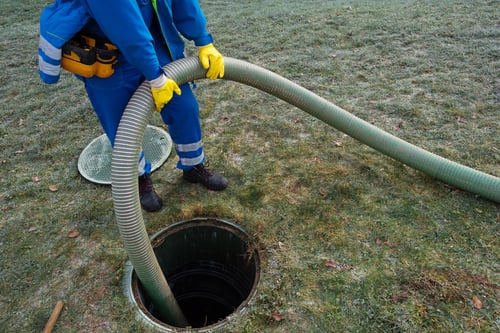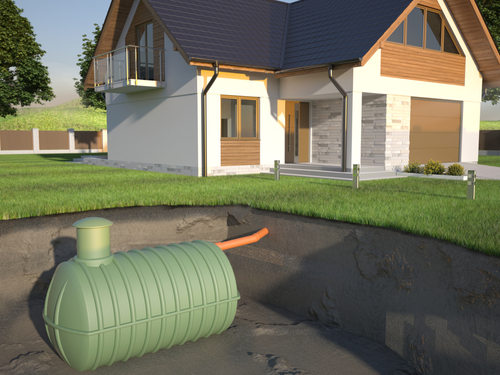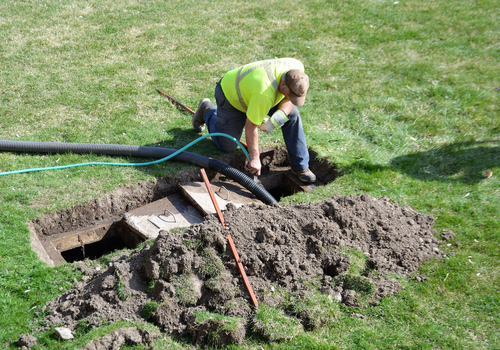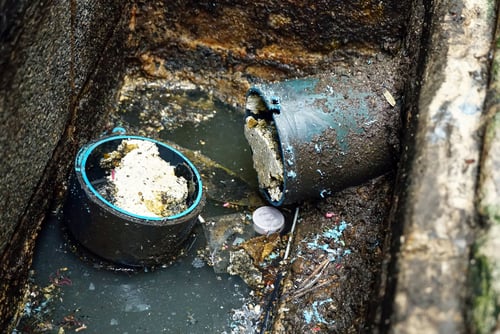Waste and water must leave our homes somehow. Either a septic system or sewer system takes the waste and properly disposes of it. However, there are a few key differences between the two systems. This article will discuss septic systems and how to maintain them. Read along as we provide a septic system maintenance checklist and tips for preventing septic issues.

What Is a Septic System and How Does It Work?
Septic systems are underground water waste treatment structures generally used in rural areas that don’t have centralized sewer systems. They use a mix of technology and nature to manage wastewater from household plumbing. For instance, they treat water from bathrooms, laundry, and kitchen drains.
Septic systems are made to dispose of water and waste efficiently and efficiently. The water and waste from your home exit through a drainage pipe and empties into a septic tank. From there, the wastewater will go through the system to a drain field, which eventually filters into the soil. First, however, you must remove the rest of the waste in the tank from time to time.
One of the main differences between a septic system and a sewer system is that one is owned and operated by the government, and one is individually maintained and operated by the homeowner. Keep reading as we go over the differences below.
Septic System vs. Sewer System

There are a few differences between septic systems and sewer systems. For instance, the local government operates standard sewer systems in more populated areas. You’ll know if your home operates with a sewer system if you pay for this utility separately or as part of your water bill.
On the other hand, septic systems are individual units associated with your home only. That said, landlords are responsible for taking care of maintenance, inspections, and costs of operating a septic system.
If you’re buying a home, the cost of the septic system is generally included in the overall home price. However, the cost of using a public sewer system varies. Sometimes, the cost is included in the water bill, while some areas separate the cost of water and sewage.
Another main difference between sewer systems and septic systems is the process of disposing of waste. A septic system breaks down the solid waste and releases liquids into a drain field. In a sewer system, the facility removes contaminants and discharges the water back into the local water supply.
The maintenance is also a bit different between the two systems. A septic system must be pumped out once a year or every couple of years, while a sewer system generally requires no maintenance. If sewer maintenance is required, it’s up to the local government to do so. However, it’s up to the homeowner if a septic system needs maintenance.
Next, let’s discuss common septic problems and how much it’ll cost to repair these issues.
Common Septic Problems and Average Costs for Repairs
If you don’t keep up with general septic system maintenance, you could run into some issues. For instance, septic system failure can cause untreated sewage to surface to the ground around the tank or become backed up in the pipes. If sewage finds its way to groundwater or surface water without anyone noticing, exposure to these contaminants can cause sickness.
Depending on the damage type and location, septic tank repairs can cost anywhere from $200 to $6,000 or more. A simple inspection should cost just a couple hundred dollars. However, a total replacement of a septic tank can cost much more–anywhere from $3,000 to $9,500.
Taking care of more minor repairs is crucial to avoid a complete replacement. Some of the most common causes of septic system failure include:
- Clogged Pipes
- Tree Roots Inflitrating Pipes
- Leaks In Sewage Tank
- Incorrect Installation
- Increased Water Use
Clogged Pipes
Clogged pipes are one of the most common septic system issues. If your septic tank is too full, you could experience slower drains or backed-up toilets. Think about when the last time you pumped out your septic. This might not be the issue if it was within the past year or two.
If you’re still experiencing issues even though you’ve pumped out your tank recently, you could have a clog in the system. Clogs typically happen when items are flushed down the toilet that shouldn’t be. To remove a clog, you may be able to push it out through the access port. However, if it’s a tougher job, you’ll have to hire a plumber to help.
Tree Roots Infiltrating Pipes
Septic tank issues can also be caused by tree roots growing in the way. Roots can cause your drain pipes to crack, which can cause major damage over time. Unfortunately, large roots can also clog your sewer pipes.
To avoid damage from tree roots, you can install plastic pipes that can withstand damage from roots. Additionally, if you’re considering planting new trees, make sure to do so away from your septic system and pipes. Finally, if you have existing tree roots near your septic pipes, treat your pipes with root growth inhibitors to avoid damage.
Leaks In Sewage Tank
Although you may like the look of bright green grass, it could be a major sign of septic malfunction. Unexplained green grass can indicate that your septic tank is sending too much water to your lateral lines, over saturating your yard.
If this is the case, you could have sewage collecting on your lawn. To avoid costly damage and avoid health issues, it’s crucial to contact a professional if you suspect a leak in your sewage tank or lateral lines.
Incorrect Installation
Correct installation of your septic system allows it to function properly and efficiently. Unfortunately, if you purchased the home after the system was installed, it’s hard to tell if it’s installed properly. That said, it’s not uncommon for these systems to be incorrectly installed.
Some common mistakes include failure to install the tank deep enough, installing the improper-size tank, or using the wrong soil in the drain field. Unfortunately, all of these mistakes can lead to septic system failure. However, if you have a septic system maintenance checklist, you should be able to catch these mistakes early on.
Increased Water Use
Septic tanks can only hold so much water–eventually, it’ll overflow. The more people that rely on the septic system, the more likely it is to fail. So, if you have a large family or expect several long-term guests, it’s crucial to find out if your septic tank can handle the increased water use.
If not, you may have to get a new, larger septic tank. If you’re living in a rental home, check with your landlord or property manager to see how large the septic tank is. Then, if you notice any major issues, such as clogs or leaks, it’s crucial to let someone know immediately.
Septic System Maintenance Checklist

Keeping your septic system well-maintained is crucial for it to work correctly. That said, septic system maintenance isn’t a once-a-month or once-a-year job. Instead, it’s best to ensure your septic is always maintained to avoid expensive repairs.
Here are some things to include on your septic system maintenance checklist to prevent a faulty system.
- Inspect your septic system frequently.
- Pump the septic tank every 2 to 3 years.
- Repair leaky plumbing fixtures and drips.
- Conserve as much water as possible.
- Dispose of household chemicals properly.
- Keep grease and cooking oil away from your drains and garbage disposal.
- Pay attention to your lawn and watch for spongy grass.
- Don’t flush certain items down the toilet.
- Plant trees away from your septic system.
If you want to prevent problems within your rental property, keep this septic system maintenance checklist in mind while checking up on your property. Remember that septic system maintenance isn’t just a yearly or monthly task. Instead, you should continuously monitor your septic system to ensure there are no significant issues.
Importance of Budgeting for Emergencies
Emergency expenses can pop up any time, whether you’ve budgeted for them. Unfortunately, septic tank repairs and replacements can be extremely pricey, especially without proper preparation. That said, it’s crucial to set aside money and create a budget for major repairs.
You can use a few savings rules to estimate property maintenance costs. For instance, the 1% rule suggests you save around 1% of the property’s overall value each year for maintenance costs.
The 50% rule suggests that landlords set aside 50% of their monthly income for routine maintenance, repairs, or emergency maintenance costs. Finally, the square footage rules recommend that landlords save around $1 per square footage of their rental home. So, for example, you’d want to save $1,500 for maintenance in a 1,500-square-foot-rental home.
If you want to catch repairs or maintenance concerns immediately, include policies in your lease agreement that require tenants to report them. If your tenant report damages or suspected septic tank issues to your rental property management company in Northern Virginia, you can save on expensive repairs.
Count on the Professionals to Maintain Your Rental
Property maintenance, tenant relations, and running a rental business can quickly become an unintended full-time job. If you own one or more rental properties and want to streamline your business, contact the property management professionals.
Bay Property Management Group offers comprehensive rental management services, including tenant screening, rent collection, maintenance, and more. We perform the day-to-day tasks, so you don’t have to. Contact BMG today if you need rental management services in Baltimore, Philadelphia, Northern Virginia, or Washington DC.

